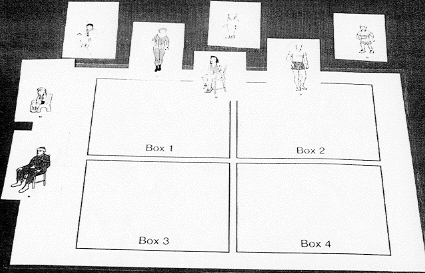6th Grade Performance Task
Contributed by: RAND
1993 Administration
Description:
Students examine two-way classification systems using four mutually
exclusive groups and two dimensions simultaneously. Students then
are given a set of plastic animals, asked to create a two-way classification
system, then asked to fit a new character into their system.
The task assesses students' abilities to make simple observations,
use observed characteristics to create a classification system,
and apply their understanding to an additional situation.
This task is designed to take students approximately 20-30 minutes
to complete.
Overall Task Content Area:
- Life Science
Specific Knowledge Areas:
-
Performance Expectations:
- conducting investigations
- gathering, organizing, and representing data
- applying scientific principles to develop explanations and solve
new problems
National Science Education Standards:
8 A SI 1: Abilities necessary to do scientific inquiry:
Grades 5-8
1.4 Develop descriptions, explanations, predictions, and
models using evidence. Students should base their explanation on
what they observed, and as they develop cognitive skills, they should
be able to differentiate explanation from description - providing
causes for effects and establishing relationships based on evidence
and logical argument. This standards requires a subject knowledge
base so the students can effectively conduct investigations, because
developing explanations establishes connections between the content
of science and the contexts within which students develop new knowledge.
1.8 Use mathematics in all aspects of scientific inquiry.
Mathematics is essential to asking and answering questions about
the natural world. Mathematics can be used to ask questions; to
gather, organize, and present data; and to structure convincing
explanations.
8 C LS 2: Reproduction and heredity: Grades 5-8
2.5 The characteristics of an organism can be described in
terms of a combination of traits. Some traits are inherited and
others result from interactions with the environment.
(Use the "hot" link on the PALS home page
to check the full text of related National Science Education Standards,
if desired.)
National Council of Teachers of Mathematics:
Algebra (AL1): Understand patterns, relations and functions.
Data Analysis and Probability (DAP1): Formulate questions
that can be addressed with data and collect, organize, and display
relevant data to answer them.
Problem Solving (PS2): Solve problems that arise in mathematics
and in other contexts.
General Instructions to the Teacher:
This task is designed to take students approximately 20-30 minutes
to complete.
Students will be working individually during this exercise.
Students should be ready to work as soon as the period begins.
The materials should be set out at each lab station, if possible.
A central supply area, if needed, should be easily accessible. All
supplies should be clearly labeled.
Materials for Classification of Animals:
The teacher will need:
- Paper cutouts representing people
- Plastic animals
- Envelopes or bags to hold cutouts and animals
- Labels
At this station students should have:
- Envelope labeled "People" containing paper cutout people
- Envelope #1 containing 8 plastic animals
- Envelope #2 containing 1 plastic animal
Advance Preparation:
- Duplicate and cut out paper people such that each student has
8 different characters to classify.
- Keep paper cutouts in an envelope labeled "People."
- Prepare envelopes labeled "#1" to contain 8 different plastic
animals.
- Prepare envelopes labeled "#2" to contain 1 plastic animal
that is different from the 8 in "#1."
Safety:
- Be careful.
- Teachers and students should always exercise appropriate safety
precautions and utilize appropriate laboratory safety procedures
and equipment when working on science performance tasks.
Extensions/modifications:


|



